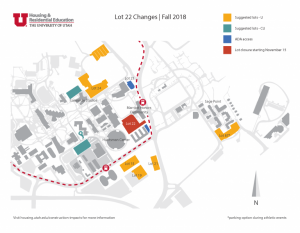Back in 2008, the University of Utah released its campus master plans for the future.
The primary goal of the plan, in respect to student housing, is to create developments of single-student apartments at key locations on campus. The South Campus Village, the site near where the modern-day Marriott Honors Residential Scholars Community (MHC) is now located, is the proposed home to around 1800 new apartments.
The plans stated that “the U’s increase in out of state students has, in turn, led to an increase in the need for on-campus housing. Students should be housed in close proximity to TRAX stations in areas conveniently located to the core academic campus area.”
The University of Utah relies heavily on the Salt Lake City community to provide rental houses and apartments to students, in addition to the more than 25 percent who continue to live at home, often with their parents.
At the moment, only about 14 percent of students reside in college-owned, operated or affiliated housing. The rest of the student body lives off campus. To combat the need for on-campus housing, Housing and Residential Education will be welcoming its newest residence hall. The dorm is set for completion in fall of 2020 and will offer 992 beds.
The new dorm will be located just west of the MHC, near the Student Life Center. It will become a space where students can increase their involvement with the university through Living Learning communities and Themed Communities. The communities that are being planned will include a Health and Wellness wing, a Technology Initiatives wing, First Year Honors communities and a Community Engagement wing.
The U Health wing will center its focus on interdisciplinary education. It will increase access to health professionals for Utah students. The Technology wing will center its focus on increasing the number of students in the stem disciplines, especially those that are underrepresented. The Community Engagement wing will connect with the U’s Bennion Center to focus on advocacy, activism and service opportunities.
The new dorm will have a fully functioning dining hall on the first floor to provide residents of the building and other hungry students with nutritious meals and snacks. The building will also include computer labs, private and shared study areas and conference rooms for students to utilize.

As construction begins, however, many are left without parking. Students at the MHC have been forced to relocate their vehicles to other parking lots around campus. The closure of parking Lot 22 has led to more difficulties in finding parking near the Marriott Honors Community, the Huntsman Center, the Annex and the HPER Buildings.
The additional closure of a large portion of Lot 24 for the construction of the new soccer stadium has also increased the need for parking.
Erica Andersen, the assistant director for communications and assessment for HRE, talked about this evolving project and its impact on parking. “We have been corresponding with students in a variety of ways,” she said. “Informing them about the new options for parking. We have been working closely with commuter services to identify some alternative lots that will open up additional U parking close to the MHC.”
As a result, HRE has added additional U permit parking in Lot 19. For those that are unfamiliar with this area, it is the surface lot directly south of the Institute Garage. Only a portion of the lot will remain reserved for Institute permits, and there are signs identifying which areas are U permit parking.


